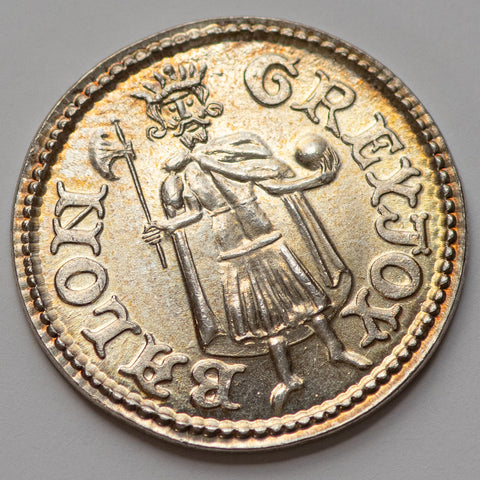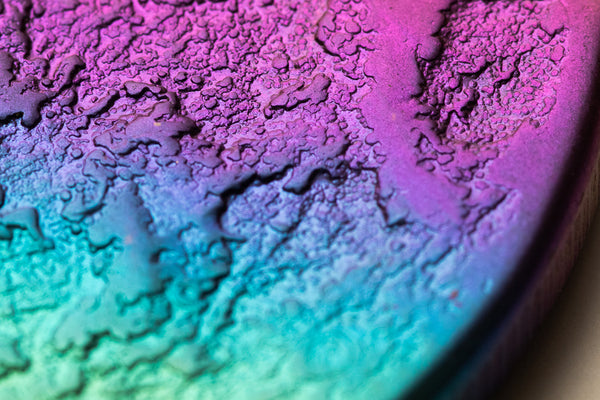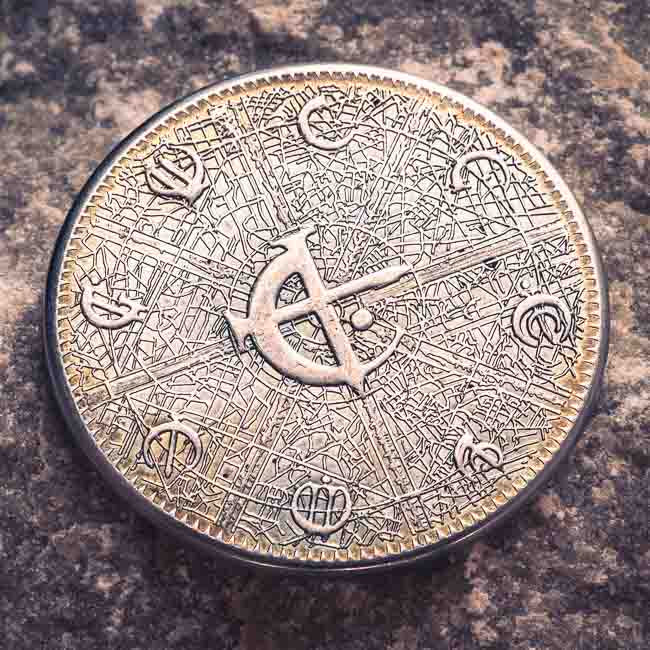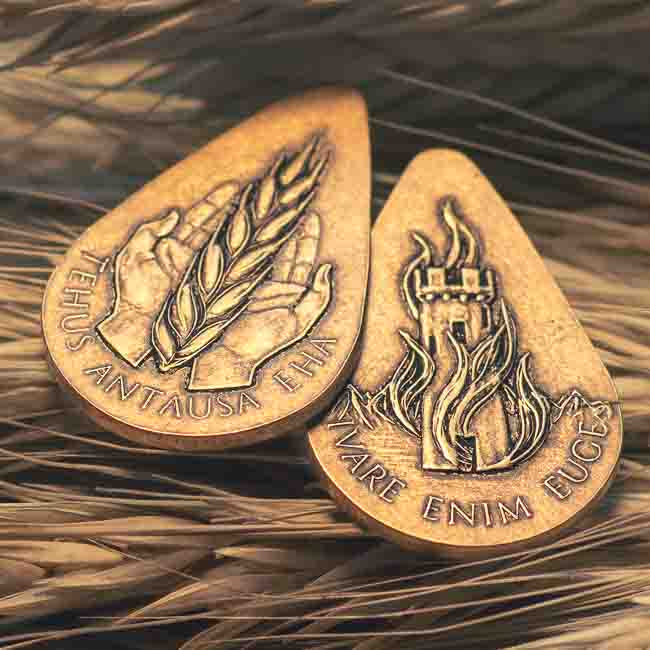Coin Care Guide
TL;DR:
Don't keep coins in a glass of saltwater.
This guide is not a strict collector's guide on keeping your coins perfect, but instead focuses on how to control your coin's finish and provides expected behaviors over time with the metals we use here at Shire Post Mint.
While numismatist-oriented care guides may advise you to wear white gloves and only handle coins by their edges, we expect that you'll be handling your coins as much as we do daily with bare hands and in open air. We will even go over some ways that you can intentionally accelerate rust and oxidation with dramatic effect, changing tone, and texture for fun if you so choose.
Below are all of the metals we use:
Non-precious Metals

- Copper
- Brass
- Bronze
- Iron
- Stainless Steel
- Nickel-Silver (named for its silvery appearance, but ironically contains no elemental silver)
Precious and Rare Metals

- Fine .999 Silver
- Niobium (the one that lets us achieve bright, saturated surface colors such as our colorful moons)
- Mokume-gane (layered copper, brass, and nickel)
- Titanium
Will my coins oxidize? How durable is the finish?
Coins with a Patina
If your coin has an "antiqued" patina then it has been sealed with a thin wax layer. We do this to protect coins' antiqued finish look. With enough handling an antiqued coin will shine brightly and only the lowest of darkened areas will stay darkened. Antiqued and sealed coins are very surface-stable unless the wax layer has been worn away and they are left in prolonged moisture.
"Mint" Coins
If your coin appears uniform in color without an added antique finish, and is bright, raw metal, we did not give your coin an additional protective layer. Don't worry, your coin isn't going to turn to dust in your hands! These coins are in "mint" condition and their base metal is open to the elements. Over a set period of time these will surface tarnish more than a sealed coin if handled and left oily. They will slightly dull if not cleaned after being handled, and will do so very gradually over time left in open air. To bring a lightly tarnished coin back to mint condition, polish gently with a soft cloth. See "Cleaning and Polishing" for more
"Avoid talking directly over coins; tiny droplets of saliva can also create spots on a coin. Just like fingerprints, these marks are difficult to remove."
-US Mint Article on Caring for Coin Collections
If left in a wet or salty environment over a prolonged period of time, any of our coins would oxidize.
Depending on the coin's material, we use liver of sulfur or other liquid-soluble oxidizing agents to darken them initially. In the final tumbling process the high spots have their dark areas brightened up to highlight the engraving.
Cleaning and Polishing
If you need to clean your coins, particularly if you're trying to prevent leaving fingerprints on mint coins most susceptible to reacting, use mild soap and water. Once you’ve washed the coins, pat them dry with a clean lint-free towel. Brushing or rubbing with abrasives can scratch the coin’s surface.
If your coins have taken on light tarnish already that you would like to remove to restore a coin's "mint" look, we recommend a jeweler's rouge polishing cloth for ease of use, and also affordability (around $5). Rouge is a fine compound developed by the jewelry trade for exactly this purpose and is even safe to use on pieces that have thin layers of plating (at the time of writing, none of our coins are plated). Numismatically speaking, polishing away at a coin's original patina would devalue it if done improperly, but we believe that as long as your coins are the finish that you want them to be, there is no harm in using a rouge cloth to restore the mint-look shine.
Below is a Balon Greyjoy Silver Stag in 99.9% Fine Silver that has, over time, accumulated surface tarnish through oxidation. There is discoloration at the surface.

It can be brought back to its original brilliant silver without much effort using a rouge cloth. Below shows a portion of the coin that's barely been rubbed with rouge compound applied to a cloth-- it is already greatly improved after a few light passes.

Small nooks of the coin near height changes will be harder to polish by hand quickly, but the coin is much more shiny and uniform than before the rouge cloth was used.

For more stubborn tarnish, Simichrome metal polish works well on our coins when applied to a soft cloth and rubbed by hand. It can be had online in convenient tubes for about $12 at the time of writing.
Properties of our Metals
Copper, Bronze and Brass
Our copper coins are 100% copper, meaning that they are not a different metal plated with copper. You don't need to worry about the surface flaking off while you are altering the patina of your coin. Brass and Bronze are likewise solid. Brass is 70% copper and 30% zinc, Bronze is 90% copper and 10% zinc.
To remove oxidation, a lightly acidic solution will help break down the copper oxide on the surface of your coin. Here are some simple recipes to break down copper oxide:
- Combine 3 parts baking soda to 1 part white vinegar to create a cleaning paste. Cover your coin in the paste for 10 minutes to 1 hour depending on the level of oxidation. Use a microfiber cloth to polish the paste into the metal. The grit of the baking soda helps to scrub away the oxide. Rinse and repeat if necessary.
- Combine 2 parts lemon juice or white vinegar and 1 part salt. Stir until the salt has dissolved. Apply to a rag or microfiber cloth and polish your coin with the mixture until the desired look is achieved. Alternately, you can add flour to the mixture to create a paste.
- For subtle changes, simply use a microfiber cloth or even just your fingers to rub the coin. The patina may alter in just the way you want it.
To prevent oxidation, use oil to create a barrier between the surface of the metal and air. Here is how you can prevent oxidation:
- Regularly handle the coin (the oils in your skin will coat the coin)
- Apply a light coat of paste wax, cooking oil, or car wax with a soft cloth
- Coat with commercial lacquer (only use if you are certain that you don't want the look to change and you don't want to feel the surface of the metal again)
To create oxidation,
- Carry your coin with you. A coin on the move will receive equal exposure to the air on both sides, aging its sides equally. This method takes the longest but also allows for the patina to grow and change with you as you handle your coin.
- For bright green/bluish patina, combine vinegar and salt in a small plastic container, about an inch deep. Create a table for your coin to sit on above the level of the mixture and leave the container open. The vaporized vinegar will combine with oxygen to create the fragile yet colorful crystals. We recommend sealing with lacquer if you'd like to keep this patina since it will wear off quickly.
Stainless Steel
You are good to go bro, there should be no problems with Stainless.
Iron
Iron as a material often concerns people for its readiness to rust a reddish brown color and interrupt the original intended finish. Our iron coins receive a durable black oxide coating as well as a wax coating before they reach you. Black oxide is a chemical and heat treatment that inhibits rust and turns the coins black. Black Iron Oxide (FeO4) molecularly takes the place of where red rust (FeO3) would form. Coins treated this way won't rust under normal circumstances ie carried in a pocket, handled daily. Woody Maringer has been carrying an Iron Coin of the Faceless Man in his pocket for two years with no signs of rust. If handled regularly, the oils from your skin will actually help create a protective barrier between the iron and moisture.

Niobium
You may notice your anodized niobium coin may slightly change color with handling. When handling all coins, small amounts of oils will deposit onto the surface, and in the case of niobium this will cause the light refraction to alter slightly, creating the appearance of a color change. Isopropyl alcohol is perfect for removing those oils to correct the color, and can be rubbed across the coin with a cloth safely without damaging the coin's anodized finish.
Anodization affects the way light refracts on the surface layer of the metal. It is not a dye. The anodization process is quite durable and niobium is one of the hardest metals we work with, but be aware that all colors will wear down slightly in high spots with continued use over time.

Mokume Gane and Titanium
Can also be cleaned with microfiber and isopropyl alcohol to remove fingerprints.
Accelerating Oxidation and Rust
There will always be some variance in coin patina due to variations in batch size, tumbling media volume, coin size, temperature etc. We take care to oxidize the coins so that the finish does not easily flake off which is an unwanted result that comes from overdoing the oxidation process, sacrificing finish durability.


